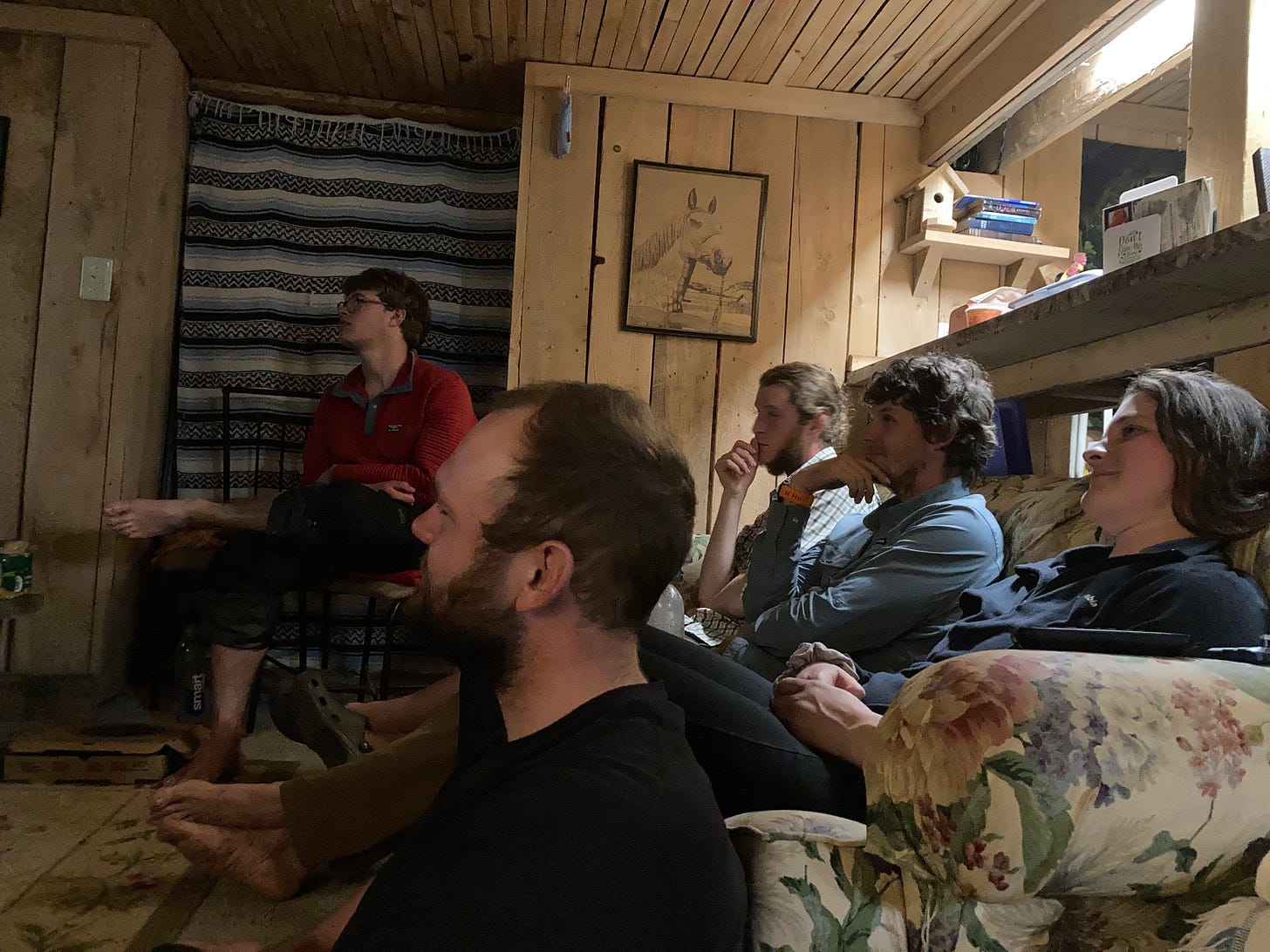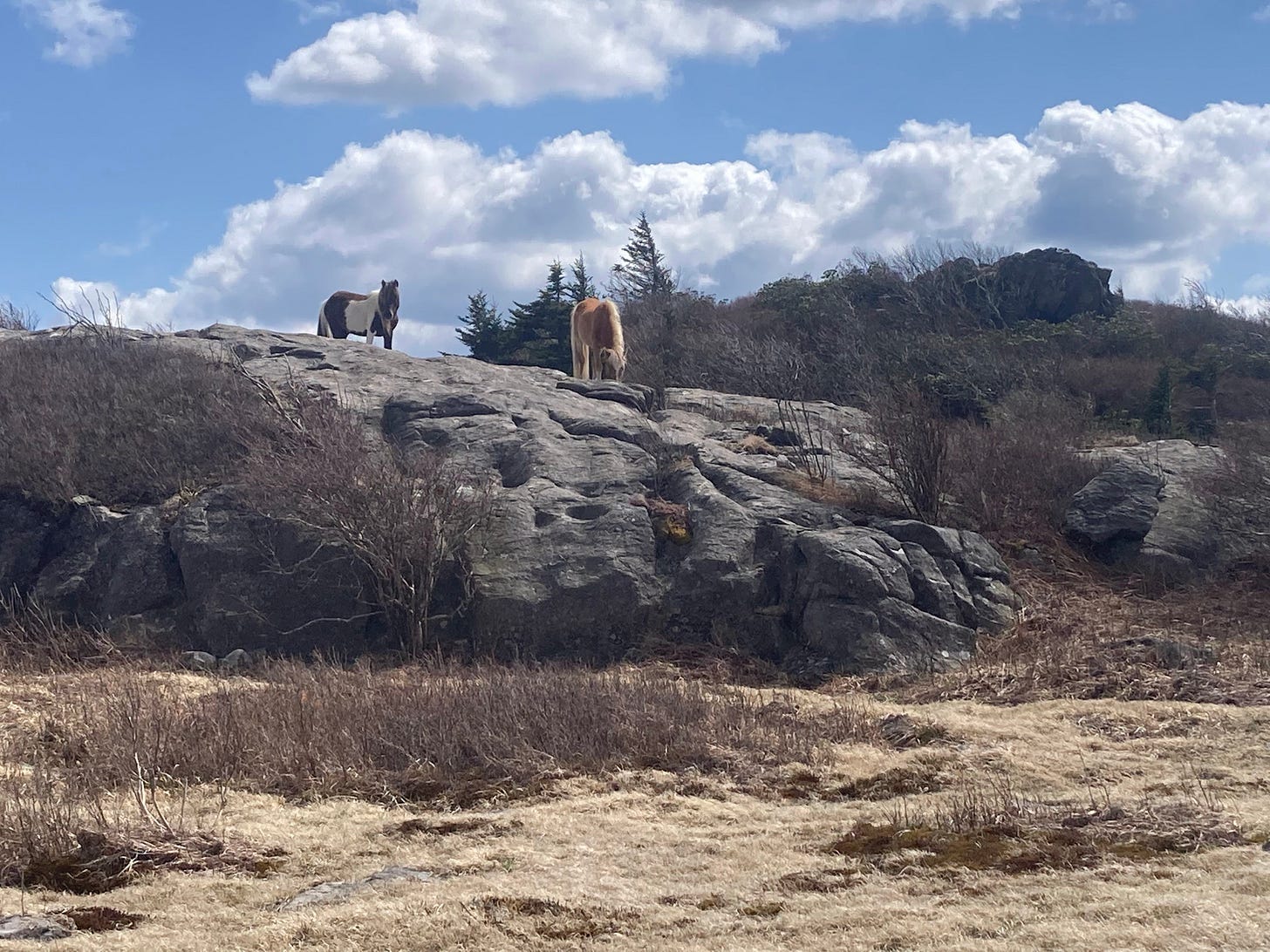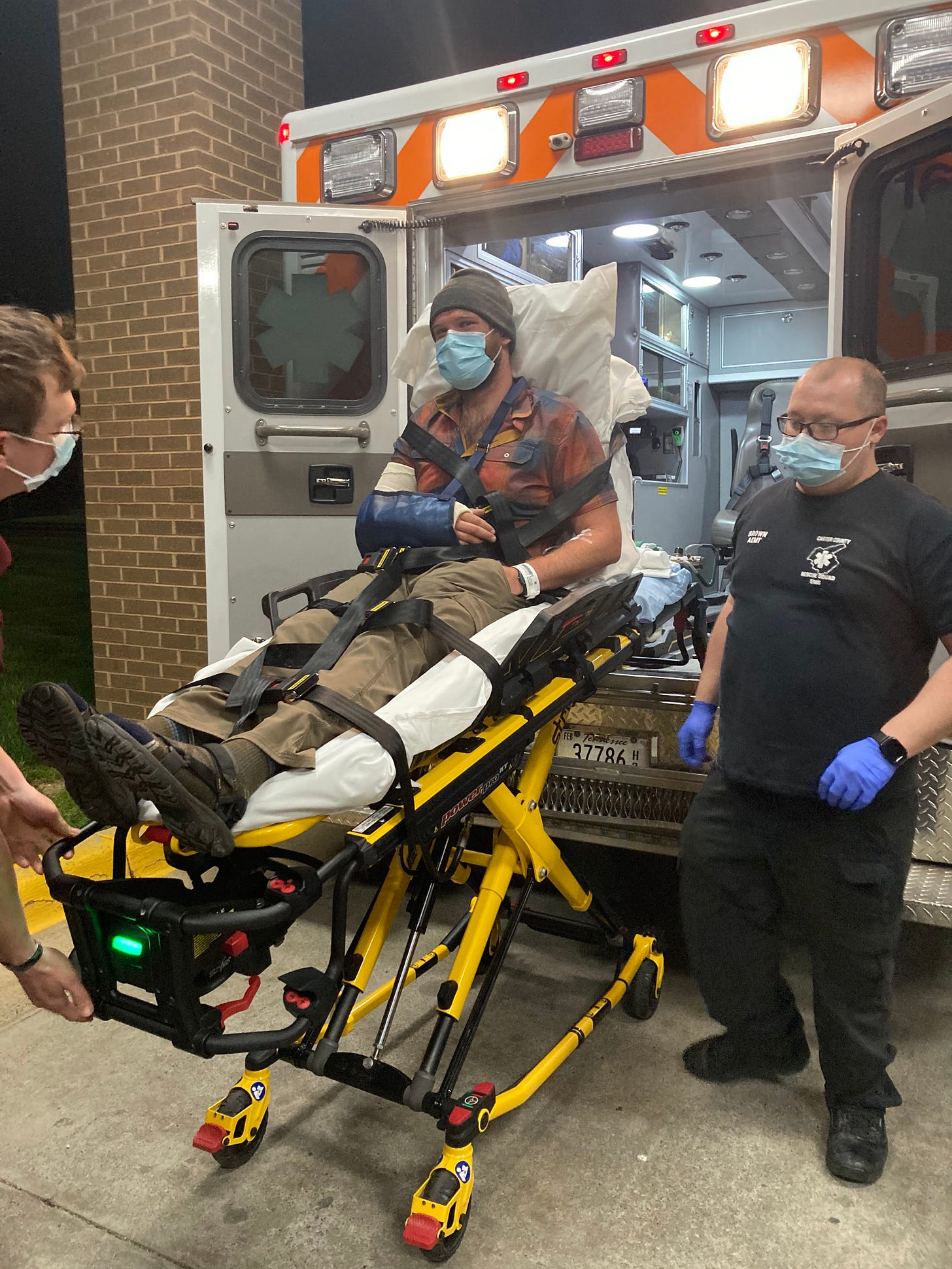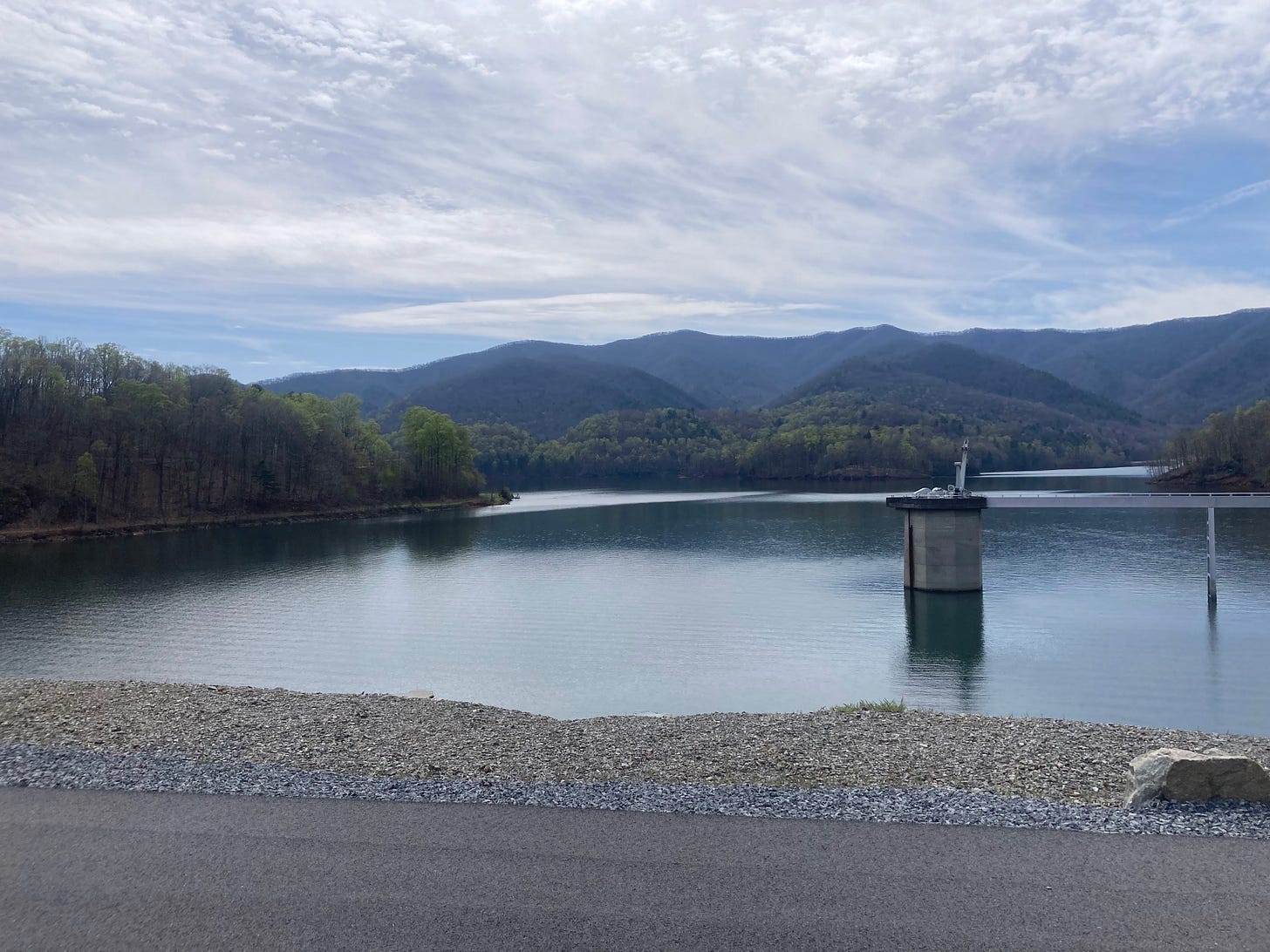Hey y’all! Back again for another post after ~300 miles that seemed to fly by. Currently drafting this post in the Pearisburg library in the grand state of Virginia on perhaps the stickiest keyboard of all time, so let’s blame any spelling mistakes on that and not my exhausted brain after a day of hiking.
In the past stretch, I rounded out the sections in North Carolina and Tennessee and have walked my way into the state of Virginia where nearly a quarter of the trail is found (the AT cuts across the state on a diagonal that nearly seems as if the trail creators were aiming to maximize time spent in the state). There’s even an infamous ailment particular to hikers in the state called “The Virginia Blues” after seeming to make no progress week over week in the same state. Fortunately, so far I’ve managed to avoid this and instead perhaps have caught “The Virginia Reds”—that is a perpetual sunburn due the lack of tree cover in many places!
This past section has also been eventful with milestones— I officially crossed the 500 miles mark and then the official quarter way mark of the trail! As I laid out in my initial post, I previously hiked a huge chunk of the trail (around 500 miles) in North Carolina and the early parts of Virginia and as of last week I past my previous section and am once again on never-before-seen trail!
In another significant milestone, officially replaced my first pair of trail runners after around ~470 miles of wear and tear jumping over rocks, through snow, and (too often) into puddles and swapped to my first new pair. For context, most hikers go through around 5 pairs of boots/trail runners on a thru-hike.
This stretch also marked a more subtle milestone— where being on trail and waking up daily and hiking, putting away my tent, and filtering water all felt entirely normal and routine. After roughly a month and a half of doing this, the rhythms of trail life, even when a thunderstorm hits or facing a rough uphill stretch, feel entirely ordinary. Paradoxically, it’s almost exciting to have the raw initial excitement of living out this dream begin to fade and actually settle into what it daily means and looks like.
That being said, for this post I’ll still lay out notable high points and low points, and will once again wrap up with something I’ve been thinking about during my miles.
Notable High Points:
On my first time hiking my section of the AT, my favorite section I passed through was the Roan Highlands. Once again, hiking through balds and panorama views was incredible.
Just after Roan, I stayed at a lovely bed and breakfast operated by a former world class French pastry chef who hiked the AT and was inspired to open up a spot on trail. Needless to say, breakfast was incredible and far beats the oatmeal/instant breakfast combination I usually have on trail. Equally as incredible was watching a movie indoors (what a luxury!) with a group of hikers that had been referenced to no end on trail.

Heading into Damascus Virginia was wonderful for a few reasons— I finally accessed a kitchen to cook a real meal for the first time in 6 weeks, I spent a day resting and lounging around in a hammock, and Henry had sent me a box of trail snacks to enjoy (including a mini pecan pie and a pack of seaweed which is exactly the kind of combination of healthy and indulgent I live for). Perhaps most importantly, it’s common knowledge on trail that the odds of someone completing a thru-hike (which is only ~20% at the start) rise to 75% after Damascus, with the vast majority of folks that aren’t going to make it dropping out before then. Making it this far is then is a great sign! (Of course injuries and accidents can happen anytime, so my fingers are still crossed)
Another wonderful component of this past stretch was Grayson Highlands where ponies run wild. After deer being the most interesting wildlife I’d seen recently on trail, I loved seeing these guys everywhere for a few miles.

Notable Low Points:
A key term on the AT is “Tramily”, meaning your trail family or group of folks that you tend to hike with.
On my second day hiking, the aforementioned horribly cold day of March 12th, I met a guy who’d get the trail name NASA and after spending a day of freezing cold hiking together, he immediately became a part of my Tramily and we hiked in the same group for roughly 400 miles. By spending so much time with people on trail (eating meals, hiking portions of the day, talking at camp), I’ve found that the AT can transform random strangers into lifelong friendships in record time.
A few weeks back after setting up tents and calling it a night, NASA asked me to come outside and help. My gut reaction was that it was gear-related assistance but one look at his arm and it was immediately clear that he had very much broken his arm after taking a fall.
I ran down the trail to find anyone with a car, literally anyone, who would be willing to drive us to hospital. Fortunately, I ran across a woman who graciously drove us into the nearest town with an urgent care. Crisis always reminds me how incredible strangers are.
After spending hours at the first hospital, we were transferred to the second in Johnson City, TN— NASA needed surgery as both primary bones in the arm were completely broken. Traditionally passengers aren’t allowed in ambulances, but given that I would otherwise be completely stranded at 2:00 a.m. in this small town with no car or way to return to the trail, I hitched a ride in the front seat. The following day, he headed into surgery and has started a lengthy recovery phase at home.
While it’s easy to think that completing the AT is a function exclusively of drive, grit, and physical endurance, in reality one of the biggest factors is simply luck. Luck that when you fall you don’t land the wrong way. Luck that you don’t slip on every rock that you step on. Luck that every mile is a safe one. He’ll be back in 2023 to hike the trail, I feel certain of that. Until then, needless to say, the low point of this section was moving on without a fantastic friend found on trail.
Something I’ve Been Thinking About:
As I’ve upped my mileage, at the end of a long day I’ll occasionally pop on a podcast to pass the hours. A week or so back, I was winding down a mountain listening to a Tim Ferris interview with Morgan Housel, author of a book on the psychology of money, as Tim, the host of the podcast, asked Morgan for general investing tips. Morgan laid out that in general he’s wary of giving investing advice primarily because everyone’s “game” is different. Someone retiring in 3 years will have a different approach to risk as someone early in their career with a longer horizon for compounding. Given this, a decision that for one individual is entirely logical, for another would be potentially harmful despite both parties engaged in the same activity of investing.
Ultimately, the specific “game” they are playing matters.
On trail, there’s an often used phrase “Hike Your Own Hike”, the gist of it being that your approach to the trail should be defined exclusively by you. One hiker who’s trail name is August, hikes extremely long days and then stops and spends multiple nights (in trail lingo called “zeros”) in the towns along the trail, maximizing his time seeing the towns and meeting people. I also met a couple who have decided to take the trail extremely slow and do 10-mile days every day but few full rest days, limiting their risk of over straining themselves. I met someone looking to complete the trail in a herculean 100 days, trying to push himself to the max physically. Bringing this back to the investing question above, each hiker may be hiking the same trail, but each has a different “game” or set of intentions that they’re taking into account. For each, a successful day on trail looks different. A successful thru-hike looks different.
Comparing the speed of one of the above hikers to another or how often they stop at views or how often they take a day off trail is a moot point— similar to judging a basketball player by how well they hit home runs given the difference in their respective approaches.
And yet on trail, it can be challenging not to compare someone’s miles to your own or what someone’s start date was as a means of determining who’s moving faster. I’ve seen hikers who’ve blown their knees trying to keep mileage with someone whose game was to max out on miles daily. I’ve also heard regrets from others about staying in towns too long because the group around them were staying that long. In these cases, we confuse someone else’s game for our own.
Thinking beyond the trail, if my personal game was exclusively to achieve professional success as fast as possible or optimize for income, I wouldn’t be hiking. Much of life, investing, thru-hiking, deciding what job to take, deciding what city to move to, what you eat, ultimately comes down to the specific game that you decide to play. By defining specifically the desired outcome of life and work, by defining clearly one’s “game”, one avoids a life filled with comparison or defaulting to what seems to be the right goal based on what everyone else is doing.
The past ~300 miles or so, I’ve started to tease out more what game I intend to play for the remainder of my twenties, with idea of having a clear definition of what I’m driving towards and what is irrelevant. With this clear definition, post-trail decisions should be easier to make, similar to how your end game helps you invest or choose your mileage and rest days appropriately.
—
And with that, like last time, wrapping up with a bank of photos below. I also (in light of the upped mileage leading to the need to listen to something on long days) welcome any and all podcasts suggestions, send them my way!
Until the next ~300 miles,
Tierney/ trail name: BeastMode


















Thank you for the update and pics! Wow!! Proud of you!